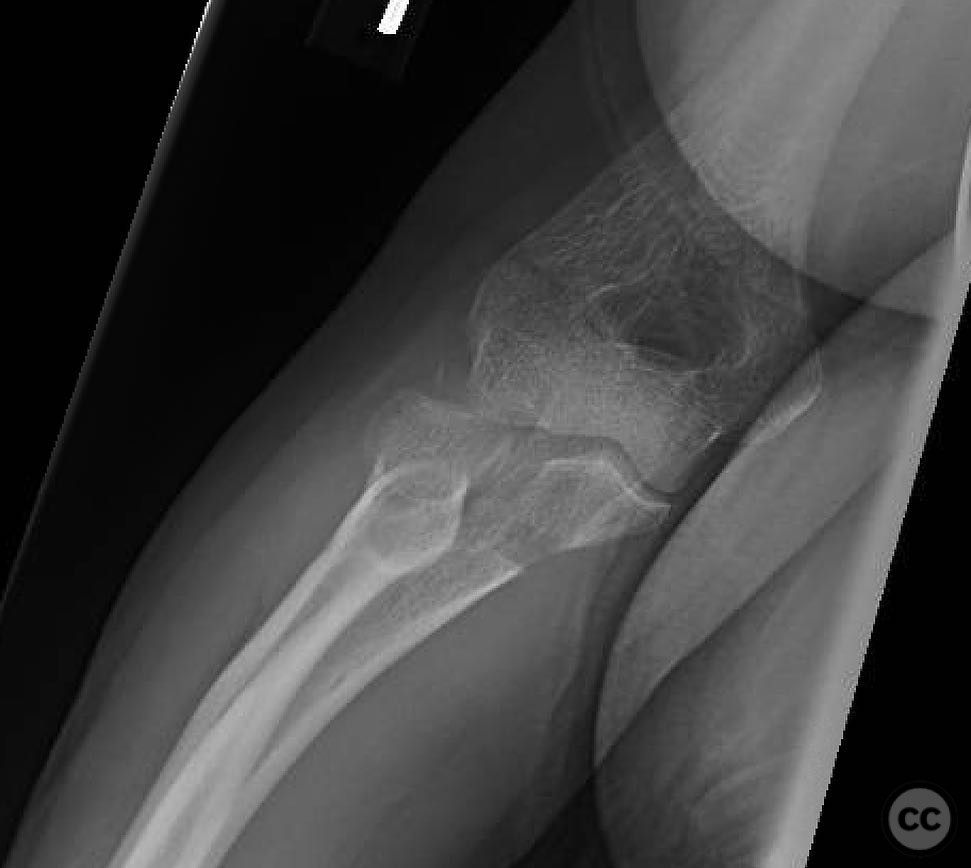Posterior Monteggia Fracture Dislocation Type 2b with Radial Head Impaction.
Score and Comment on this Case
Clinical Details
Clinical and radiological findings: A 61-year-old patient presented following a slip on ice, resulting in a posterior Monteggia fracture dislocation. Radiological assessment confirmed a Type 2b fracture, located just distal to the coronoid process. The injury was associated with a minor radial head impaction fracture. No significant ligamentous or capsular injuries were noted.
Preoperative Plan
Planning remarks: The preoperative plan involved an open reduction and internal fixation of the proximal ulna fracture through a posterior approach. The surgical strategy included achieving anatomic reduction of the ulna to facilitate spontaneous reduction of the radiocapitellar joint.
Surgical Discussion
Patient positioning: The patient was positioned in a lateral decubitus position to allow optimal access to the posterior aspect of the elbow.
Anatomical surgical approach: A posterior approach to the elbow was utilized, involving a midline incision over the olecranon extending distally along the subcutaneous border of the ulna. Subperiosteal dissection was performed to expose the fracture site for reduction and fixation.
Operative remarks:The surgeon noted that with anatomic reduction of the proximal ulna, the radiocapitellar joint reduced spontaneously. It was emphasized that persistent dislocation of the radiocapitellar joint post-fixation often indicates inadequate reduction of the ulna, necessitating reassessment and correction of the ulnar alignment.
Postoperative protocol: Postoperative rehabilitation included early mobilization with a focus on regaining range of motion. Weight-bearing restrictions were applied until radiographic evidence of fracture healing was observed.
Follow up: Not specified.
Orthopaedic implants used: Orthopaedic implants used included a plate and screw construct for fixation of the proximal ulna fracture.
Search for Related Literature

orthopaedic_trauma
- United States , Seattle
- Area of Specialty - General Trauma
- Position - Specialist Consultant

Industry Sponsership
contact us for advertising opportunities


 are the most common type of monteggia fracture in adults. Not so in children. Type 2 fractures are broke_3.jpg)
 are the most common type of monteggia fracture in adults. Not so in children. Type 2 fractures are broke_2.jpg)
 are the most common type of monteggia fracture in adults. Not so in children. Type 2 fractures are broke_4.jpg)
 are the most common type of monteggia fracture in adults. Not so in children. Type 2 fractures are broke_6.jpg)
 are the most common type of monteggia fracture in adults. Not so in children. Type 2 fractures are broke_5.jpg)
 are the most common type of monteggia fracture in adults. Not so in children. Type 2 fractures are broke_1.jpg)
 are the most common type of monteggia fracture in adults. Not so in children. Type 2 fractures are broken(.jpg)
Article viewed 72 times
23 Jul 2025
Add to Bookmarks
Full Citation
Cite this article:
Surname, Initial. (2025). Posterior Monteggia Fracture Dislocation Type 2b with Radial Head Impaction.. Journal of Orthopaedic Surgery and Traumatology. Case Report 28590310 Published Online Jul 23 2025.